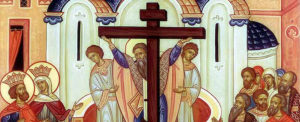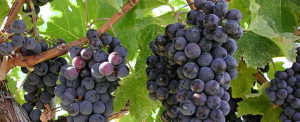It’s hard to believe, but today we have already passed one half the period between the Resurrection of Christ and the coming of the Holy Spirit. Today is the unique day called the Midfeast, looking back at the resurrection and forward to Pentecost.
On this day the Church remembers Christ’s teaching in the temple at midfeast. (In fact these events in John 7 took place during the Feast of Tabernacles, but they offer teaching about our own expectation here at our own midfeast.)
On the last day, that great day of the feast, Jesus stood and cried out, saying, “If anyone thirsts, let him come to me and drink. He who believes in me, as the scripture has said, out of his heart will flow rivers of living water.” But this he spoke concerning the Spirit, whom those believing in him would receive; for the Holy Spirit was not yet given, because Jesus was not yet glorified (John 7:37-39).
The Jewish book called the Mishnah describes in details the celebration of the Feast of Tabernacles when the temple was still standing in Jerusalem.
One of the high points of this feast was the pouring out of water on the second evening of the feast (Suk. iv. 1, 42b). Drawing and pouring out water to the Lord was a very ancient practice, described in 1 Samuel 7:6.
At the Feast of Tabernacles, a golden pitcher was filled by a priest with water from the Sheep’s Pool at Siloam, and brought into the temple as the multitude sang, “With joy you will draw water from the wells of salvation” (Isaiah 12:3). As trumpets were blown, the water was poured together with an offering of wine onto the altar (Suk. iv. 9, 10; Tosef., Suk. iv.).
“The festivity of the season attained its height on the evening following the first day [of the feast]. Of this celebration it is said that whoever has not witnessed it has never seen a real festivity (Suk. v. 1). In the brilliantly illuminated court of the women, before the assembled multitude occupying the double gallery erected by the priests and Levites, the most prominent Israelites took part in a torch-dance, reciting at the same time hymns and songs of praise. Meanwhile on the steps of the inner court stood the Levites singing Psalms 120-134, accompanied by various musical instruments. The celebration continued till cockcrow… In Yer. Suk. v. [the outpouring] is called “the house of drawing the water” because thence the Holy Spirit is drawn (comp. Tosef., Suk. iv., beginning; Levy, “Neuhebr. Wörterb.” s.v. ”Sho’ebah”).” (from the Jewish Encyclopedia on “the Feast of Tabernacles”)
It is in this context of water being poured out in the temple, symbolizing the Holy Spirit, that the Lord begins teaching about himself:
Gospel reading for today: John 7:14-30; 37-39
Now about the middle of the feast Jesus went up into the temple and began to teach. And the Jews were amazed, saying, “How does this man know learning, having never been taught?”
Jesus answered them and said, “My doctrine is not mine, but his who sent me. If anyone wants to do his will, he will know concerning the doctrine, whether it is from God or whether I speak on my own authority. He who speaks from himself seeks his own glory; but he who seeks the glory of the One who sent him is true, and no unrighteousness is in him. Did not Moses give you the law? But not one of you keeps the law. Why do you seek to kill he?”
The people answered and said, “You have a demon. Who is seeking to kill you?”
Jesus answered, “I performed one miracle, and you are all amazed. Yet because Moses gave you circumcision (not that it came from Moses, but from the forefathers), you circumcise a male child on the Sabbath. If a man receives circumcision on the Sabbath, so that the law of Moses should not be broken, are you angry with me because I made a man completely well on the Sabbath? Do not judge by what you see, but judge with proper judgment.”
Now some of them from Jerusalem said, “Is this not he whom they seek to kill? But look! He is speaking publicly, and no one is saying anything to him. Do the rulers know indeed that this is truly the Messiah? But we know where this man is from; when the Messiah comes, no one will know where He comes from.”
Jesus was still teaching in the temple courtyard, and he cried out “You know me, and you know where I am from. I have not come on my own authority, but he who sent me is true. You do not know him, but I know him, for I have come from him, and he sent me.”
So they sought to seize him; but no one laid a hand on him, because his hour had not yet come.
The Church reflects on these things for our instruction in the hymns of Vespers for the midfeast:
The middle of the days has come, beginning with the Savior’s Resurrection, and sealed by the holy Pentecost. The first and the last shine with splendor. We rejoice in the union of both feasts, as we draw near to the Lord’s Ascension: the sign of our coming glorification.
Sion heard and rejoiced when it received the glad tidings of Christ’s resurrection from Hades. All her faithful offspring were filled with joy on beholding him who by the grace of the Spirit washes away all the stain of Christ’s murder. They all prepare to celebrate festively the joyous midfeast and holy day of both the feasts.
The abundant outpouring of the Divine Spirit is drawing near, as the Scripture says. This is proclaimed by the mid-point of the blessed days which follow Christ’s death, burial and arising, when he gave his disciples his unfailing promise, which revealed the coming of the Comforter.
We have assembled, O Christ, to praise the miracle of thy mysteries: the midfeast of thy Resurrection and the coming of thy Holy Spirit. Send down on us thy great mercies!
The middle of the fifty days is here, wherein Christ revealed his divine power. He healed the paralytic, raising him from his bed by a word. In a manner fitting for God, he worked miracles in a body of clay, granting mankind eternal life and great mercy.
Thou didst come to the temple, O Wisdom of God, in the middle of the feast, to teach and reprove the disobedient Jews, Pharisees, and teachers of the law. With boldness thou didst cry out to them, “Let him who thirsts come to me and drink the water of life, and he will never thirst unto eternity! Whoever believes in me, streams of living water shall flow from him.” How great is thy goodness and Thy compassion, O Christ our God! Glory to thee!
Jesus went up to the temple in the middle of the feast, and proclaimed to the disobedient Jews: “Let him who thirsts come to me and drink living and everlasting water, and he will never thirst unto eternity. He who believes in me, rivers shall flow from him, and he shall have the light of life.
O Savior, while thou wast teaching the Jews in the midst of the feast, they murmured: “How can this man be learned, who was never taught?” They did not know that thou art the Wisdom that fashioned the world. Glory to Thee!
Troparion of the Feast (Tone 8)
At midfeast, grant my thirsting soul to drink of the waters of piety, as thou, O Savior, didst cry out to all: “Whoever is thirsty, let him come to me and drink!” O Wellspring of life, Christ our God, glory be to thee!
Spoilers!
Last Sunday we read about the healing of the paralytic at the sheep’s pool at Siloam, in the place named Bethesda [House of Mercy]. Today we see that blessed water from the House of Mercy poured out in an offering to God on the altar, in expectation of the coming of the Holy Spirit.
This coming Sunday we will see the Lord’s conversation with Saint Photini, the Samaritan woman: “Whoever drinks of the water that I shall give him will never thirst. But the water that I shall give him will become in him a fountain of water springing up into everlasting life.”
The Gospel readings and commemorations are chosen with a purpose. In these weeks while the risen Christ remains with his apostles, the Church is teaching us the mysteries contained in our baptism, while building our expectation for the coming of the Holy Spirit at Pentecost.





